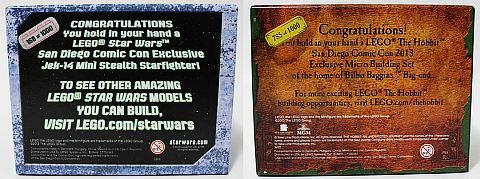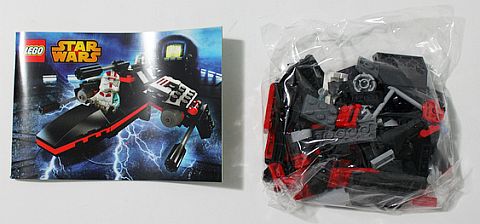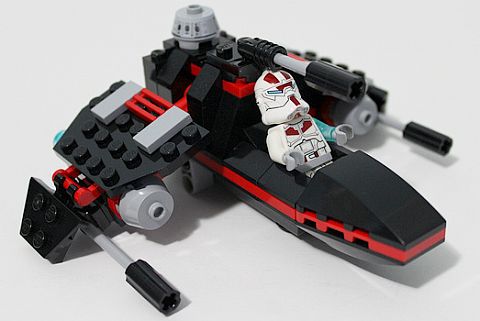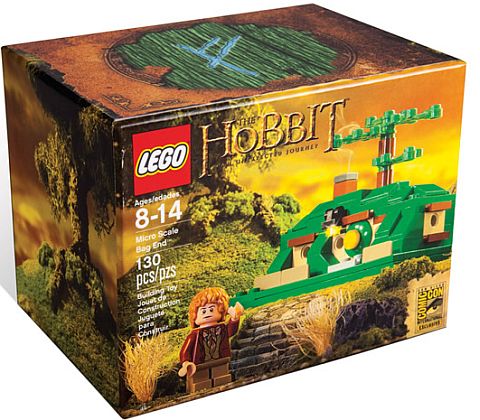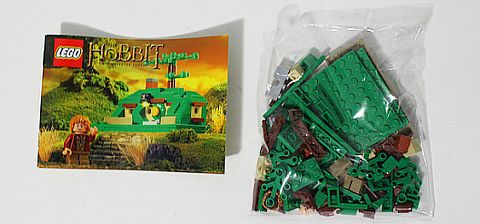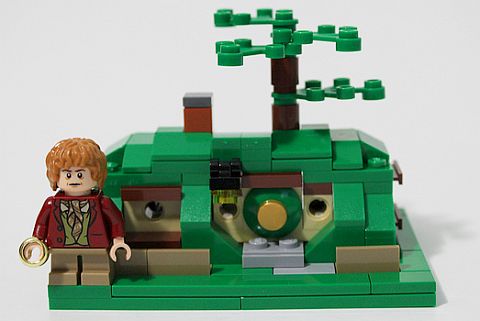(Written by William)
In this Brick Breakdown series I review official LEGO sets, from the perspective of looking at interesting building techniques we can all learn from. Today we will be looking at the #70503 LEGO Ninjago Golden Dragon. You can check out the previously discussed LEGO building techniques found in official LEGO sets at the end of this article. 🙂

If there is one thing the LEGO Ninjago line should be known for is the dragons. Not only do you have dragons for the four major elements, and an epic combined dragon with four heads, but you also get a Golden Dragon! That makes for a nice variety of LEGO dragon heads to choose from. The special feature of all of the Ninjago dragons is that besides the moulded heads, they are all built from regular LEGO elements. For us this means plenty of unique LEGO building techniques to enjoy.
➡ LEGO JOINT TECHNIQUES
Most LEGO mechs and robots use similar joints and in the same places. This is because they are typically created around a humanoid frame. However, the LEGO Ninjago Golden Dragon set features a dragon, which is one of the farthest things from looking like a human. Therefore a set like this makes a wonderful and interesting display of the various joint techniques that can be used with LEGO elements.

Let’s start with the simplest clip & bar connection. This particular connection is seen in three places in the LEGO Ninjago Golden Dragon set: first in the construction of the front claws, second where the wings meet the body, and third in the connection of the tail. This type of joint construction provides a smooth and free-moving action, and you can use several LEGO elements to achieve it. The problem is that the connection is quite delicate and can’t hold a lot of weight, so it is better suited for decorative details. Note that where the wings meet the body, the clips are doubled just to add enough support.
Next we have the swivel hinge-plates. These are the joints that allow the Ninjago dragon’s wings to be spread. When compared to the larger LEGO brick equivalent of this element, the plates are a bit more rigid and sturdy. Often they look best when chained to other hinge-plates to create a seamless curve. However if you use five hinges at once their form will begin to sag. Note that in the wings of the Ninjago dragon they’re mostly angled with their studs up. This is their most secure orientation.
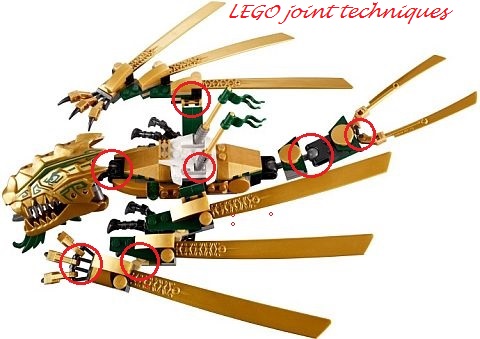
There are also two pin-connections in the construction of the Ninjago dragon. The first is in the wings and uses a LEGO friction-pin. This makes a solid rotating element that can hold a decent amount of weight. It’s probably not the piece you want to use to hold a LEGO model up over time, but it can work to mount other parts of your LEGO model at interesting angles. The other pin-connection is the locking-pin, located where the legs meet the body of the Ninjago dragon. To my knowledge there are not many locking-pin elements in LEGO’s inventory. These joints are made to both turn and rotate. Also, thanks to their locking design, they can handle the most weight out of the simple joint construction techniques. If you’re looking for the most efficient way to have supporting legs, this is the joint you want. To get stronger joints, you’ll need to use various LEGO Technic elements.
Speaking of locking-hinges, there are two of the two-finger variety that are holding up the flags. These are solid connection points that make odd angles a breeze. To hold up larger sections of your LEGO model you may need to double them up to provide full support.
Finally, there are the LEGO ball-joints. The LEGO Ninjago Golden Dragon set uses two of these connections in slightly different ways. The head uses it purely for the freedom of movement it grants. The tail-connection is also to provide range of motion, but since ball-joints are a bit stiff, the connection also helps to balance the whole dragon when standing up. This is a minor difference but since the ball-joint is capable of providing support, there’s little reason not to take advantage of this characteristic. Just know that you’ll never want to use a ball-joint in a leg-construction unless you’re making an ultra light LEGO model. The ball-joint can collapse under heavier weight.
➡ LEGO FLATAPULT
No, that title is not a typo. LEGO manages to sneak in catapult designs in hundreds of their sets to add some action. This means that they have the opportunity to experiment with a wide range of mechanisms. Ultimately what it comes down to is that each catapult emphasizes a different method to deliver the flinging action. Some count on a long arm to increase the force of the missile, others have a counterweight that overcomes the mass of the projectile. Still others use a rubber-band to create tension. And the LEGO Ninjago Golden Dragon features yet another version I call the “Flatapult”.
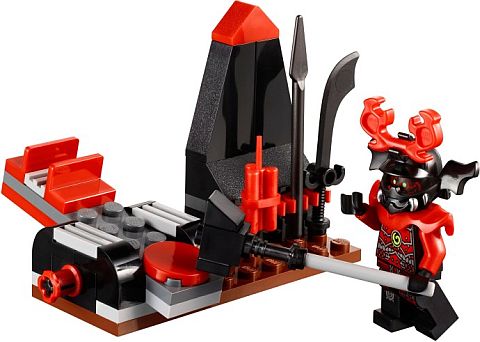
The distinct characteristic of a Flatapult is that it is very low to the ground. There is little to its turn action, thus giving it a very flat profile (hence the name, “Flatapult”) The source of this catapult action comes directly from the person’s suddenness in triggering it. A slow activation will produce very little in the way of flinging, while a sudden move can make the projectile (or in this case a minifigure) fly quite a distance.
The reason why such a design is used has more to do with the type of arch you want to form when launching the minifigure, as the direction of the force goes up more than forward. So what you end up with is a high arching launch that kind of symbolizes a very big leap.
➡ APPLYING WHAT YOU LEARN
Large action-figure LEGO models like dragons often look better when they can be posed appropriately. For that to happen, you need to be careful of the joints you use to make your model look right. In addition, it looks bad if parts keep coming off in your hand when you try to move your model in a certain direction. Chances are that if parts come off, it is due to not layering and interlocking your pieces. However, it can be because you didn’t use the right joints for the job. The LEGO Ninjago Golden Dragon set makes a good example of when and where certain joints should be used.
As for the Flatapult, it is less important that you know how to make one than it is to understand that each LEGO catapult design offers a little something different. This difference is often seen in how it launches its projectiles. A siege-engine, for instance, is often bigger for achieving height and range, while something mounted on top of a wall is small since it only needs to have a good range. Truth be told, the flat design found in the LEGO Ninjago Golden Dragon set is better suited for launching breakaway walls than for launching minifigures. The reason for this is because walls tend to need the upwards momentum to pull them off any studs they are attached to. This makes the action flow better and a bit more dynamic. However, the choice is ultimately up to you and whatever you are trying to accomplish.
So what do you think? How do you like the LEGO building techniques in the LEGO Ninjago Golden Dragon set? Have you been experimenting with LEGO joint techniques? And how about making awesome LEGO catapults? Feel free to share your own experiences, tips or ask questions in the comment section below! 😉
And you might also like to check out the other reviews in this series:
- Brick Breakdown: LEGO Superman Black Zero Escape
- Brick Breakdown: LEGO Tower of Orthanc
- Brick Breakdown: LEGO City Dump Truck
- Brick Breakdown: LEGO Monster Fighters Ghost Train
- Brick Breakdown: LEGO Lone Ranger Silver Mine Shootout
- Brick Breakdown: LEGO Lone Ranger Constitution Train Chase
- Brick Breakdown: Ninjago Temple of Light
- Brick Breakdown: LEGO Lone Ranger Colby City Showdown
- Brick Breakdown: LEGO Lone Ranger Comanche Camp
- Brick Breakdown: LEGO Lone Ranger Stagecoach
- Brick Breakdown: LEGO Star Wars AT-RT
- Brick Breakdown: LEGO Arkham Asylum Part 1
- Brick Breakdown: LEGO Arkham Asylum Part 2
- Brick Breakdown: Legends of Chima Polybags



